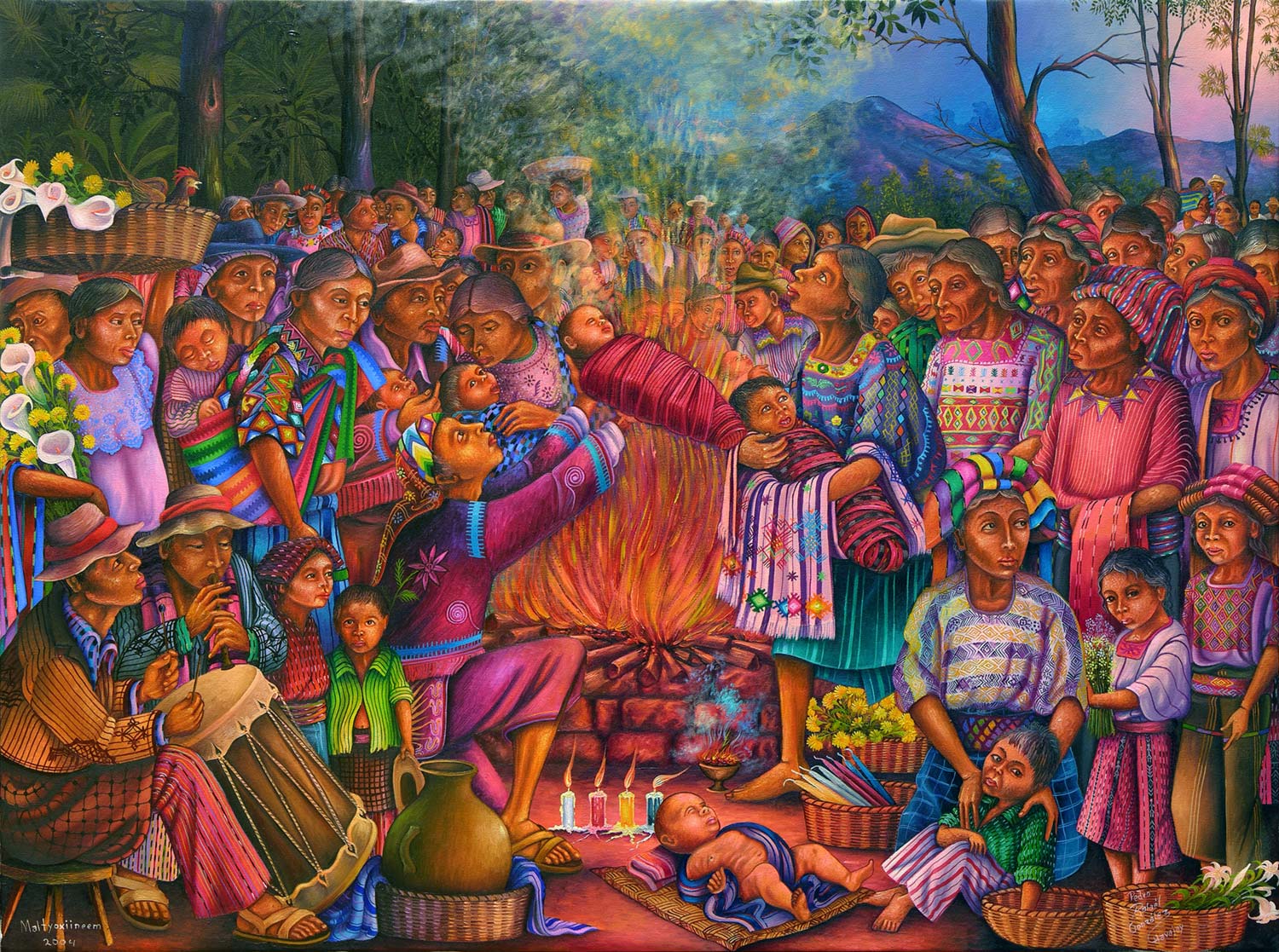This Maya ceremony for bringing children into the community and blessing them, is similar in spirit to the Christian baptism ceremony, except that fire rather than water is used for purification. The Catholic Church does not recognize it as a Christian ceremony, so it is conducted in a sacred ceremonial site outside of the town.
Artist Pedro Rafaél González Chavajay explains the symbology of the painting:
Maltyoxiineem means “Gratitude to God.” Our Tz’utuhil and Kaqchikel ancestors or grandparents believed in the Ajaw, the Lord of the Sky and the Earth. This painting shows the presentation of children to the Ajaw in a ceremony similar to Christian baptism, at which the Maya priest, or ajq’iij, officiated. The Catholic Church today baptizes infants and newborn babies. Evangelicals also practice baptism with grown children and adults. For this occasion the Maya of different villages, wearing their distinctive traditional clothing and speaking different indigenous Maya languages, gathered together at a sacred location where ceremonies, healings, and other rites were performed. This occurred in the summertime during the Maya new year. The ceremony involved mostly newborns, but sometimes older children. At the end of the presentation of the children, the parents held a big fiesta because now the child was part of the family, part of the community, and recognized by the Lord of the Sky and the Earth.
Note that the Tz’utujil term Maltyoxiineem (or K’amowaaneem, in K’iche’) can be translated as “Appreciation for What Was Received.”
For the Tz’utujila ’and Kaqchikela’, the formal name of the “Ajaw” (of the “Lord”) is Tepew Q’uq’kumatz. The ajq’iij referenced by Pedro Rafaél is a day counter. Note also that in the Maya culture, water is not used for the presentation, but rather the presentation of offerings, white flowers that symbolize the life of the new Being.
In the same way, they carry out another special ritual around the day or special date of the child, where they ask the parents to look for a strong tree, to which they must bring an offering as well. This signifies the sowing or the basis of the life of the boy or the girl. It is another way of expressing the presentation of the children. This is public, and the activity serves to open the space for the formal presentation of the boy or girl in a ceremonial center. In addition, this rite assures that the boy or the girl may live in harmony with sacred Nature.
The artist Pedro Rafaél continues:
Today this type of ceremony is not seen very often; however, we are rescuing our Maya culture, especially our religion. Catholic or evangelical Christian baptism is seen more frequently, in their respective churches. The largest remaining ceremonial site for San Pedro is a place called Chi kaqajaay. Unfortunately, the Catholics have divided it in half and now there is a small modern building containing a statue of the Virgin, where they say Mass every week. The other half is used for Maya ceremonies. Two more small sites still exist, which are used for various rituals. Some of our traditional ritual sites have disappeared, but these three still exist.
Why is there a Maya priest from Chichicastenango at this ceremony in San Pedro la Laguna? According to my grandfather, people would invite a priest from a different village whenever possible. Nowadays, when they have a priest from the same village that is sponsoring the ceremony, people from villages near and far will take advantage of the opportunity to present their newborn babies to the Ajaw. Parents also take advantage of the opportunity to present their young children, if need be. This is why the painting shows many different types of traditional dress, because the people come from different villages.
There was a time when Maya spirituality stopped being practiced in large communities such as Quetzaltenango, among others. However, the small villages, cantons and hamlets continued and preserved this practice. Nowadays, thanks to the social struggles for the rights and the vindication of the Maya culture, these sacred practices of the presentation of Maya boys and girls are realized once again.


